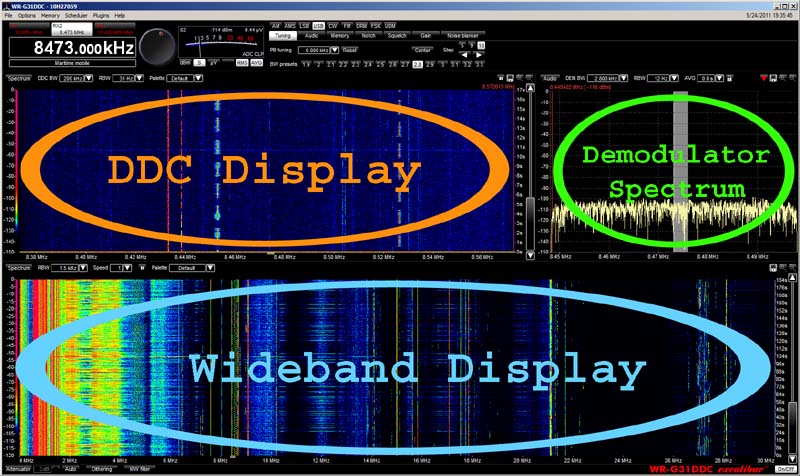This is opinion, but personally I find the WinRadio G3xDDC series to be most useful in this application. They (or rather their software) allow you to zoom in and out on, and shift the visual center of, the waterfall without loosing data.
The below screen shot is the main GUI of the WinRaido G31DDC, but all of them, G31, G33, G35, G39, and G65 use a similar layout.
The "DDC Display" is the selected operational bandwidth of the SDR. I.e. if you have 1 MHz of bandwidth selected this window will show the spectrum or the waterfall (user selectable) for that bandwidth. It can be visually zoomed in to show narrower pieces of spectrum, i.e. you have it set to 1 MHz, but you are zoomed in and only show 25 kHz of spectrum.
The "Demodulator Spectrum" is a 64 kHz (or smaller, depending on user DDC bandwidth selection) display around the tuned frequency. With a 64 kHz or larger DDC selection this is 64 kHz wide, but below 64 kHz DDC selection reduces this to match the DDC selection. I.e. if you have 2, 1, 0.64, 0.2 (etc) MHz selected in the DDC window this window is 64 kHz wide, but if you have 50 kHz in the DDC window this window is 50 kHz wide, 40 kHz selected on DDC will make it 40 kHz wide, etc.
The "Wideband Display" in the bottom third shows the full bandwidth of the SDR, in this case it can be set to either 30 or 50 MHz of bandwidth. This spectrum window can also be zoomed to narrower values than the full width, i.e. you have 50 MHz of spectrum selected, but are visually zoomed in to show only 1 MHz of spectrum.
The inclusion of two different waterfalls or spectrums, one the full tuning width and one sample width, is unusual, and extremely useful. But more importantly, once written to the waterfall the data is not gone until the signal times out, rolling off the waterfall. That means I can zoom in, look closely at a signal on the waterfall, and zoom back out, without the waterfall being re-written, and the data of other signals lost.
To the best of my knowledge the WinRadio GUI is the only one that allows this combination of operations (two different waterfalls and the ability to zoom in/out without data loss).
Now, if WinRadio would understand that waterfalls fall down, not up, it would be better.
T!


